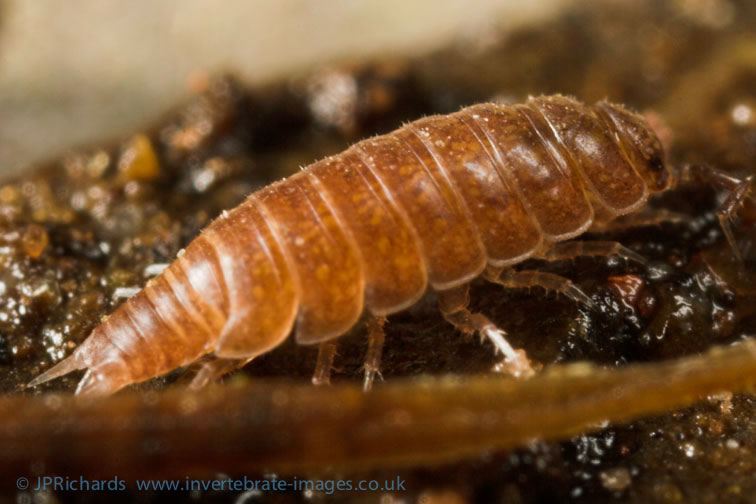Trichoniscus provisorius Racovitza, 1908
Common name
Synonyms
- Trichoniscus pusillus form provisorius Racovitza, 1908
- Trichoniscus pusillus ssp. provisorius Racovitza, 1908
Status:
GB IUCN status: Least Concern
ID Difficulty
Identification
The pygmy woodlice of family Trichoniscidae (and Styloniscidae) are readily distinguished from other woodlice by the shape of the antennal fagellum which comprises a tapered cone (of indistinct segments) bearing a terminal bristle.
Trichoniscus species are characterised by having the eyes composed of three ommatidia and a smooth body surface. Body and eye pigments are retained in alcohol.
Trichoniscus provisorius is morphologically identical to T. pusillus sensu stricto, but is relatively smaller (gravid females rarely exceed 3.5 mm in length). It is a normal sexually reproducing species, with populations comprising approximately 50/50 male and females.
Males are readily recognised by microscopic examination of the first exopod (see image and BMIG Newsletter 18, pg.2).
Distribution
Trichoniscus provisorius appears to be very common throughout Britain and Ireland but unfortunately most records do not differentiate between the two species (simply given as T. pusillus agg.). Verified records (based on male specimens) indicate a wide distribution throughout Britain and Ireland, but it seems more common in areas where calcareous strata occur.
Habitat
It favours sunnier and/or drier situations than Trichoniscus pusillus s.str., including semi-natural limestone grassland, free-draining woodland and domestic gardens (both species my occur in close proximity). It is readily found under stones, dead wood, etc.
This summary is based on the detailed account in Gregory (2009).
References
Gregory, S. (2009) Distinguishing species within the Trichoniscus pusillus species aggregate, BMIG Newsletter 18: pg 2.
Gregory, S. (2009) Woodlice and Waterlice (Isopoda: Oniscidea & Asellota) in Britain and Ireland. Field Studies Council/Centre for Ecology & Hydrology.
Links
World List of Marine, Freshwater and Terrestrial Isopod Crustaceans: https://www.marinespecies.org/isopoda/aphia.php?p=taxdetails&id=263749






